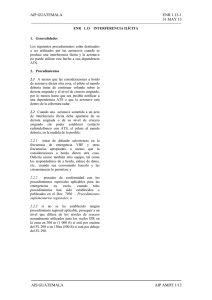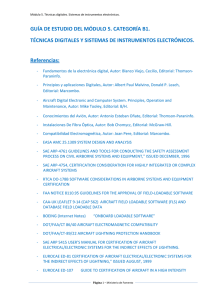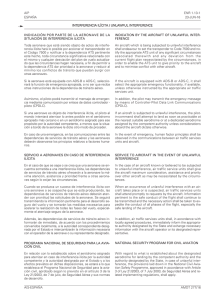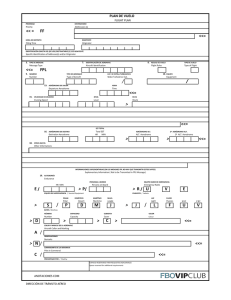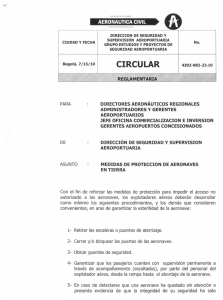ENR-4ta edicion TRABAJO FINAL
Anuncio
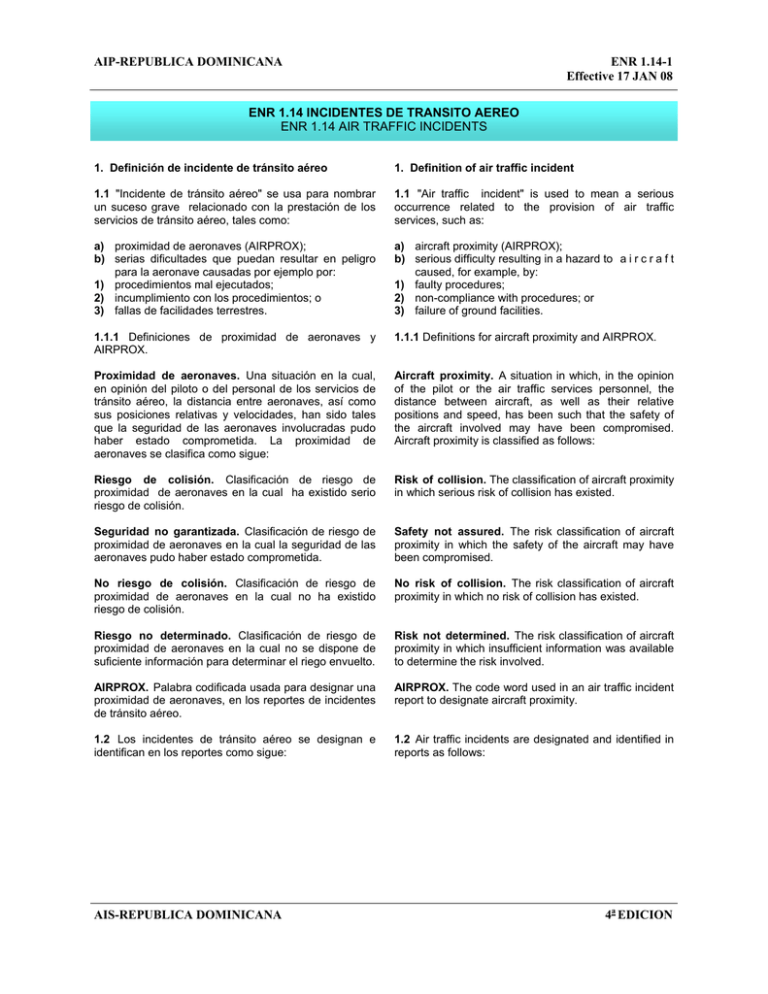
AIP-REPUBLICA DOMINICANA ENR 1.14-1 Effective 17 JAN 08 ENR 1.14 INCIDENTES DE TRANSITO AEREO ENR 1.14 AIR TRAFFIC INCIDENTS 1. Definición de incidente de tránsito aéreo 1. Definition of air traffic incident 1.1 "Incidente de tránsito aéreo" se usa para nombrar un suceso grave relacionado con la prestación de los servicios de tránsito aéreo, tales como: 1.1 "Air traffic incident" is used to mean a serious occurrence related to the provision of air traffic services, such as: a) proximidad de aeronaves (AIRPROX); b) serias dificultades que puedan resultar en peligro para la aeronave causadas por ejemplo por: 1) procedimientos mal ejecutados; 2) incumplimiento con los procedimientos; o 3) fallas de facilidades terrestres. a) aircraft proximity (AIRPROX); b) serious difficulty resulting in a hazard to a i r c r a f t caused, for example, by: 1) faulty procedures; 2) non-compliance with procedures; or 3) failure of ground facilities. 1.1.1 Definiciones de proximidad de aeronaves y AIRPROX. 1.1.1 Definitions for aircraft proximity and AIRPROX. Proximidad de aeronaves. Una situación en la cual, en opinión del piloto o del personal de los servicios de tránsito aéreo, la distancia entre aeronaves, así como sus posiciones relativas y velocidades, han sido tales que la seguridad de las aeronaves involucradas pudo haber estado comprometida. La proximidad de aeronaves se clasifica como sigue: Aircraft proximity. A situation in which, in the opinion of the pilot or the air traffic services personnel, the distance between aircraft, as well as their relative positions and speed, has been such that the safety of the aircraft involved may have been compromised. Aircraft proximity is classified as follows: Riesgo de colisión. Clasificación de riesgo de proximidad de aeronaves en la cual ha existido serio riesgo de colisión. Risk of collision. The classification of aircraft proximity in which serious risk of collision has existed. Seguridad no garantizada. Clasificación de riesgo de proximidad de aeronaves en la cual la seguridad de las aeronaves pudo haber estado comprometida. Safety not assured. The risk classification of aircraft proximity in which the safety of the aircraft may have been compromised. No riesgo de colisión. Clasificación de riesgo de proximidad de aeronaves en la cual no ha existido riesgo de colisión. No risk of collision. The risk classification of aircraft proximity in which no risk of collision has existed. Riesgo no determinado. Clasificación de riesgo de proximidad de aeronaves en la cual no se dispone de suficiente información para determinar el riego envuelto. Risk not determined. The risk classification of aircraft proximity in which insufficient information was available to determine the risk involved. AIRPROX. Palabra codificada usada para designar una proximidad de aeronaves, en los reportes de incidentes de tránsito aéreo. AIRPROX. The code word used in an air traffic incident report to designate aircraft proximity. 1.2 Los incidentes de tránsito aéreo se designan e identifican en los reportes como sigue: 1.2 Air traffic incidents are designated and identified in reports as follows: AIS-REPUBLICA DOMINICANA 4a EDICION ENR 1.14-2 Effective 17 JAN 08 Tipo Incidente de tránsito aéreo como como como AIP-REPUBLICA DOMINICANA Designación Incidentes. Type Designation Air Traffic incident a) arriba AIRPROX (proximidad de aeronave). b) 1) y 2) arriba Procedimiento. b) 3) arriba facilidad. as as as Incident. a) above AIRPROX. (aircraft proximity) b) 1) and 2) above Procedure. b) 3) above Facility. 2. Uso del Formato de Reporte de Incidente de Tránsito aéreo (ver el modelo en páginas ENR 1.14-5 a 1.14-12) 2. Use of the Air Traffic Incident Report Form ( See model on pages ENR 1.14-5 to 1.14-12) El Formato de Incidente de Tránsito Aéreo está destinado a ser usado: The Air Traffic Incident Report Form is intended for use: a) Por un piloto para llenar un reporte sobre un incidente de tránsito aéreo después de llegar, o para confirmar un reporte hecho inicialmente por radio durante el vuelo; a) by a pilot for filing a report on an air traffic incident after arrival or for confirming a report made initially by radio during flight. Nota.- El formato, si está disponible abordo, puede también ser usado como patrón para hacer un reporte inicial en vuelo. Note.- The form, if available on board, may also be of use in providing a pattern for making the initial report in flight. b) por una dependencia ATS para registrar un reporte de incidente de tránsito aéreo recibido por radio, teléfono o teleimpresor. b) by an ATS unit for recording an air traffic incident report received by radio, telephone or teleprompter. Nota.- El formato puede usarse para transmitir el texto de un mensaje a través de la red AFS. Note.- The form may be used as the format for the text of a message to be transmitted over the AFS network. 3. Procedimientos para el Reporte (Incluyendo procedimientos en vuelo) 3. Reporting procedures) 3.1 Los que siguen son los procedimientos de notificación a seguir por un piloto que se haya visto involucrado en un incidente: 3.1 The following are the procedures to be followed by pilot who is or has been involved in an incident: a) durante el vuelo, use la frecuencia apropiada tierra/ aire para reportar un incidente de mayor significación, particularmente si están involucradas otras aeronaves, lo que permitiría una investigación más rápida; a) during flight, use the appropriate air/ground frequency for reporting an incident of major significance, particularly if it involves other aircraft, so as to permit the facts to be ascertained immediately; b) tan pronto como sea posible después de aterrizar, presentar un Formato de Reporte de Incidente completo. b) as promptly as possible after landing, submit a completed Air Traffic Incident Report Form. 1. para confirmar un reporte de un incidente hecho como en a) o para hacer un reporte inicial del incidente si no ha sido posible hacerlo por radio; 2) Para reportar un incidente el cual no requiera notificación tan pronto ocurra. 4a EDICION procedures (including in-flight 1. for confirming a report of an incident made initially as in a) above, or for making the initial report on such an incident if it had not been possible to report it by radio; 2) For reporting an incident which did not require immediate notification at the time of occurrence. AIS-REPUBLICA DOMINICANA AIP-REPUBLICA DOMINICANA ENR 1.14-3 Effective 17 JAN 08 3.2 Un reporte inicial hecho por radio deberá contener la siguiente información: 3.2 An initial report made by radio should contain the following information: a) identificación de la aeronave; b) tipo de incidente, eje: proximidad de aeronave; c) el incidente; 1. a) y b); 2. a), b), c), d), n); 3. a), b), c), i); 4. a), b); y d) misceláneas: 1.e). a) aircraft identification; b) type of incident, e.g. aircraft proximity; c) the incident; 1.a) and b); 2. a), b), c), d), n); 3. a),b), c); i); 4. a), b); and d) miscellaneous: 1. e). 3.3 El reporte formal de un incidente reportado inicialmente por radio, o el reporte inicial de cualquier otro incidente, deberá presentarse a el Instituto Dominicano de Aviación Civil o a la dependencia ATS del aeropuerto donde se realice el primer aterrizaje. Los pilotos deberán completar el Formato de Reporte de Incidente con detalles suplementarios del reporte inicial, de ser necesario. 3.3 The confirmatory report on an incident initially reported by radio, or the initial report on any other incident, should be submitted to the Instituto Dominicano de Aviación Civil, or to the ATS Office of the aerodrome of first landing. The pilot should complete the Air Traffic Incident Report Form, supplementing the details of the initial reports as necessary. Nota: Donde no haya dependencia ATS, el reporte podrá presentarse en cualquier otra dependencia del Instituto Dominicano de Aviación Civil. Note: Where there is no ATS Office, the report may be submitted to any other office of Instituto Dominicano de Aviación Civil. 4. Propósito del reporte y llenado del formulario 4. Purpose of reporting and handling of the form 4.1 El propósito del reporte de proximidad de aeronave y su investigación es promover la seguridad de las aeronaves. El grado de riesgo que resulte de un incidente de proximidad de aeronave deberá ser determinado en la investigación del incidente y clasificado como "riesgo de colisión", "seguridad no garantizada", "no riesgo de colisión" o "riesgo no determinado". 4.1 The purpose of the reporting of aircraft proximity incidents and their investigation is to promote the safety of aircraft. The degree of risk involved in an aircraft proximity incident should be determined in the incident investigation and classified as "risk of collision", "safety not assured", "no risk of collision", or "risk not determined". 4.2 El propósito del formulario es proveer a las autoridades investigadoras de una información sobre un incidente aéreo tan completa como sea posible para permitirles devolver al piloto o al explotador los resultados de la investigación lo más rápido posible, y, si procede, las medidas correctivas tomadas. 4.2 The purpose of the form is to provide investigatory authorities with as complete information on an air traffic incident as possible and to enable them to report back, with the least possible delay to the pilot or operator concerned, the result of the investigation of the incident and, if appropriate, the remedial action taken. AIS-REPUBLICA DOMINICANA 4a EDICION ENR 1.14-4 Effective 17 JAN 08 AIP-REPUBLICA DOMINICANA Intencionalmente en Blanco Intentionally Left Blanc 4a EDICION AIS-REPUBLICA DOMINICANA AIP-REPUBLICA DOMINICANA ENR 1.14-5 Effective 17 JAN 08 FORMULARIO DE NOTIFICACIÓN DE INCIDENTES DE TRÁNSITO AÉREO Para presentar y recibir informes sobre incidentes de tránsito aéreo. En el informe inicial por radio, deberían incluirse los conceptos que aparecen en sombreado. A – IDENTIFICACIÓN DE LA AERONAVE B – TIPO DE INCIDENTE AIRPROX/PROCEDIMIENTO/INSTALACIÓN* C – EL INCIDENTE 1. Generalidades a) Fecha/hora del incidente UTC b) Posición 2. Aeronave propia a) Rumbo y ruta b) Velocidad verdadera medida en ( ) kt ( ) km/h c) Nivel y reglaje del altímetro d) Aeronave en ascenso o descenso e) Angulo de inclinación lateral de la aeronave ( ) Alas en horizontal ( ) Inclinación lateral ligera ( ) Inclinación lateral moderada ( ) Inclinación lateral pronunciada ( ) Invertido ( ) Desconocido ( ) Derecha ( ) Desconocida ( ) Deslumbramiento ( ) Pilar del parabrisas ( ) Parabrisas sucio ( ) Otra estructura del puesto de pilotaje ( ) Ninguna f) Dirección de la inclinación lateral de la aeronave ( ) Izquierda g) Restricciones de visibilidad (seleccione tantas como corresponda) h) Utilización de las luces de la aeronave (seleccione tantas como corresponda) ( ) Luces de navegación ( ) Luces estroboscópicas ( ) Luces de cabina ( ) Luces rojas anticolisión ( ) Luces de aterrizaje/rodaje ( ) Luces de iluminación ( ) Otras ( ) Ninguna del empenaje i) Advertencia de evitar otro tránsito emitida por el ATS ( ) Si, basada en radar ( ) Si, basada en información ( ) Si, basada en otra ( ) Si, basada en información ( ) Si, basada en otra ( ) Tipo ( ) Aviso de tránsito ( ) Aviso de resolución emitido ( ) Identificación radar ( ) Ninguna identificación radar ( ) No visual información j) Información de tránsito expedida ( ) Si, basada en radar ( ) No visual información k) Sistema anticolisión de a bordo – ACAS ( ) No instalado ( ) Aviso de tránsito o aviso emitido de resolución no emitido l) Identificación radar ( ) Ningún radar disponible * Suprima lo que no corresponda AIS-REPUBLICA DOMINICANA 4a EDICION ENR 1.14-6 Effective 17 JAN 08 AIP-REPUBLICA DOMINICANA AIR TRAFFIC INCIDENT REPORT FORM For use when submitting and receiving reports on air traffic incidents. In an initial report by radio, shaded items should be included. A – AIRCRAFT IDENTIFICATION B – TYPE OF INCIDENT AIRPROX/PROCEDURE/FACILITY* C – THE INCIDENT 1. General a) Date/time of incident UTC b) Position 2. Own aircraft a) Heading and route b) True airspeed measured in ( ) kt ( ) km/h c) Level and altimeter setting d) Aircraft climbing or descending e) Aircraft bank angle ( ) Wings level ( ) Slight bank ( ) Moderate bank ( ) Steep bank ( ) Inverted ( ) Unknown ( ) Right ( ) Unknown ( ) Sunglare ( ) Windscreen pillar ( ) Dirty windscreen ( ) Other cockpit structure ( ) None f) Aircraft direction of bank ( ) Left g) Restrictions to visibility (select as many as required) h) Use of aircraft lighting (select as many as required) ( ) Navigation lights ( ) Strobe lights ( ) Cabin lights ( ) Red anti-collision lights ( ) Landing / taxi lights ( ) Logo (tail fin) lights ( ) Other ( ) None i) Traffic avoidance advice issued by ATS ( ) Yes, based on visual sighting ( ) Yes, based on other information ( ) Yes, based on visual sighting ( ) Yes, based on other information ( ) Not carried ( ) Type ( ) Traffic advisory issued ( ) Resolution advisory ( ) Traffic advisory or resolution advisory not issued ( ) Yes, based on radar ( ) No j) Traffic information issued ( ) Yes, based on radar ( ) No k) Airborne collision avoidance system – ACAS l) Radar identification ( ) No radar available ( ) Radar identification ( ) No radar identification * Delete as appropriate 4a EDICION AIS-REPUBLICA DOMINICANA AIP-REPUBLICA DOMINICANA ENR 1.14-7 Effective 17 JAN 08 m) Otras aeronaves ( ) Sí ( ) No ( ) Se avisó la aeronave que no era n) Se tomaron medidas de prevención ( ) Sí ( ) No o) Tipo de plan de vuelo IFR/VFR/ninguno* 3. Otras aeronaves a) Tipo y distintivo de llamada/matrícula (si se conoce) b) Si a) se desconoce, describa a continuación ( ) Ala alta ( ) Ala media ( ) Ala baja ( ) 1 motor ( ) 2 motores ( ) 3 motores ( ) 4 motores ( ) Más de 4 motores ( ) Giroavión Marcas, color u otros detalles c) Aeronaves en ascenso o descenso ( ) Vuelo horizontal ( ) En ascenso ( ) en descenso ( ) Alas en horizontal ( ) Inclinación lateral ligera ( ) Inclinación lateral moderada ( ) Inclinación lateral pronunciada ( ) Invertido ( ) Se desconoce d) Angulo de inclinación lateral de las aeronaves ( ) Desconocido e) Dirección de la inclinación lateral de las aeronaves ( ) Derecha ( ) Desconocida ( ) Luces de navegación ( ) Luces estroboscópicas ( ) Luces de cabina ( ) Luces rojas anticolisión ( ) Luces de aterrizaje/rodaje iluminación ( ) Luces de iluminación ( ) Otras ( ) Ninguna del empenaje ( ) Izquierda f) Luces utilizadas ( ) Desconocidas g) Advertencia de evitar otro tránsito emitida por el ATS ( ) Si, basada en radar ( ) Si, basada en información ( ) Si, basada en otra ( ) Si, basada en información ( ) Si, basada en otra ( ) No ( ) Se desconoce ( ) No visual información ( ) Se desconoce h) Información de tránsito expedida ( ) Si, basada en radar ( ) No visual información ( ) Se desconoce i) Medidas de prevención adoptadas ( ) Si * Suprima lo que no corresponda AIS-REPUBLICA DOMINICANA 4a EDICION ENR 1.14-8 Effective 17 JAN 08 AIP-REPUBLICA DOMINICANA m) Other aircraft sighted ( ) Yes ( ) No ( ) Wrong aircraft sighted n) Avoiding action taken ( ) Yes ( ) No o) Type of flight plan IFR/VFR/none* 3. Other aircraft a) Type and call sign/registration (if known) b) If a) above not known, describe below ( ) High wing ( ) Mid wing ( ) Low wing ( ) 1 engine ( ) 2 engines ( ) 3 engines ( ) 4 engines ( ) More than 4 engines ( ) Rotorcraft Marking, colour or other available details c) Aircraft climbing or descending ( ) Level flight ( ) Climbing ( ) Descending ( ) Wings level ( ) Slight bank ( ) Moderate bank ( ) Steep bank ( ) Inverted ( ) Unknown ( ) Right ( ) Unknown ( ) Navigation lights ( ) Strobe lights ( ) Cabin lights ( ) Red anti-collision lights ( ) Landing/taxi lights ( ) Logo (tail fin) lights ( ) Other ( ) None ( ) Unknown d) Aircraft bank angle e) Aircraft direction of bank ( ) Left f) Lights displayed ( ) Unknown g) Traffic avoidance advice issued by ATS ( ) Yes, based on radar ( ) Yes, based on visual sighting ( ) Yes, based on other information ( ) Yes, based on visual sighting ( ) Yes, based on other information ( ) No ( ) Unknown ( ) No ( ) Unknown h) Traffic information issued ( ) Yes, based on radar ( ) No ( ) Unknown i) Avoiding action taken ( ) Yes 4a EDICION AIS-REPUBLICA DOMINICANA AIP-REPUBLICA DOMINICANA ENR 1.14-9 Effective 17 JAN 08 4. Distancia a) Distancia horizontal mínima b) Distancia vertical mínima 5. Condiciones meteorológicas del vuelo a) IMC/VMC* b) Por encima/por debajo* de las nubes/niebla/calima o entre capas* c) Distancia vertical desde la nube m/ft* por debajo m/ft* por encima d) Dentro de nubes/lluvia/nieve/aguanieve/niebla/calima* e) Volando contra/a espaldas* del sol f) Visibilidad de vuelo m/km* 6. Cualquier otra información que el piloto al mando considere importante D – INFORMACIÓN DIVERSA 1. Información relativa a la aeronave que notifica a) Matrícula de la aeronave b) Tipo de aeronave c) Explotador d) Aeródromo de salida e) Aeródromo del primer aterrizaje destino f) Notificada por radio u otros medios a (nombre de la dependencia ATS) a las UTC g) Fecha/hora/lugar donde se ha rellenado el formulario 2. Cargo, dirección y firma de la persona que presente el informe a) Cargo b) Dirección c) Firma d) Número de teléfono * Suprima lo que no corresponda AIS-REPUBLICA DOMINICANA 4a EDICION ENR 1.14-10 Effective 17 JAN 08 AIP-REPUBLICA DOMINICANA 4. Distance a) Closest horizontal distance b) Closest vertical distance 5. Flight weather conditions a) IMC/VMC* b) Above/below* clouds/fog/haze or between layers* c) Distance vertically from cloud m/ft* below m/ft* above d) In cloud/rain/snow/sleet/fog/haze* e) Flying into/out of* sun f) Flight visibility m/km* 6. Any other information considered important by the pilot-in-command D – MISCELLANEOUS 1. Information regarding reporting aircraft a) Aircraft registration b) Aircraft type c) Operator d) Aerodrome of departure e) Aerodrome of first landing destination f) Reported by radio or other means to (name of ATS unit) at time UTC g) Date/time/place of completion of form 2. Function, address and signature of person submitting report a) Function b) Address c) Signature d) Telephone number * Delete as appropriate 4a EDICION AIS-REPUBLICA DOMINICANA AIP-REPUBLICA DOMINICANA ENR 1.14-11 Effective 17 JAN 08 3. Cargo y firma de la persona que recibe el informe a) Cargo b) Firma E – INFORMACIÓN SUPLEMENTARIA FACILITADA POR LA DEPENDENCIA ATS INTERESADA 1. Recepción del informe a) El informe se recibió por AFTN/radio/teléfono/otro medio (especifíquese)* b) Informe recibido por (nombre de la dependencia ATS) 2. Detalles de las medidas de la ATS Autorización, incidente observado (en el radar/visualmente, advertencia dada, resultado de la encuesta local etc.) * Suprima lo que no corresponda AIS-REPUBLICA DOMINICANA 4a EDICION ENR 1.14-12 Effective 17 JAN 08 AIP-REPUBLICA DOMINICANA 3. Function and signature of person receiving report a) Function b) Signature E – SUPPLEMENTARY INFORMATION BY ATS UNIT CONCERNED 1. Receipt of report a) Report received via AFTN/radio/telephone/other (specify)* b) Report received by (name of ATS unit) 2. Details of ATS action Clearance, incident seen (radar/visually, warning given, result of local enquiry etc.) 4a EDICION AIS-REPUBLICA DOMINICANA AIP-REPUBLICA DOMINICANA ENR 1.14-13 Effective 17 JAN 08 DIAGRAMAS DE AIRPROX / AIRPROX GRAPHICS Situar la posición de una de las aeronaves implicadas en el centro del gráfico e indicar su rumbo sobre el correspondiente radio del círculo. Situar la posición de la/s otra/s aeronaves, marcando la trayectoria y rumbo. Place one of the involved aircraft at the graphic centre, indicating its heading on the appropiate circle radius. Place the other/s aircraft indicating path and heading. 14 13 12 11 10 9 8 7 6 5 4 3 2 1 0 1 2 3 4 5 6 7 8 9 10 11 12 13 14 10 9 8 7 6 5 4 3 2 1 0 1 2 3 4 5 6 7 8 9 10 300 270 240 210 180 150 120 90 60 30 0 30 60 90 120 150 180 210 240 270 300 Señale en el diagrama el paso de otra/s aeronave/s con respect a su propia aeronave, suponiendo que USTED se encuentra en el centro de cada diagrama. Mark in the graphic the passing of the other/s aircraft in relation to your own aircraft, supossing YOU are located in the centre of the graphic. Indique el primer avistamiento y la distancia de paso. Indicate the first sight and the passing distance. Nota: IDENTIFIQUE CLARAMENTE TODAS LAS AERONAVES. Note: IDENTIFY CLEARLY ALL AIRCRAFT. AIS-REPUBLICA DOMINICANA METROS / METERS 10 9 8 7 6 5 4 3 2 1 0 1 2 3 4 5 6 7 8 9 10 CIENTOS DE METROS / HUNDRED OF METERS CIENTOS DE PIES / HUNDRED OF FEETS CIENTOS DE METROS / HUNDRED OF METERS CIENTOS DE METROS / HUNDRED OF METERS 14 13 12 11 10 9 8 7 6 5 4 3 2 1 0 1 2 3 4 5 6 7 8 9 10 11 12 13 14 4a EDICION ENR 1.14-14 Effective 17 JAN 08 AIP-REPUBLICA DOMINICANA INSTRUCCIONES PARA COMPLETAR EL FORMULARIO DE NOTIFICACIÓN DE INCIDENTES DE TRÁNSITO AÉREO INSTRUCTIONS TO FILE THE AIR TRAFFIC INCIDENT REPORT INFORM CONCEPTO CONCEPT A Identificación de la aeronave que presente el informe. A Identification of aircraft presenting the report. B Un informe AIRPROX debería transmitirse inmediatemente por radio. B An AIRPROX report should be transmitted inmediately by radio. C1 Fecha/hora UTC y posición en marcación y distancia de una ayuda para la navegación o en LAT/LONG. C1 Date/UTC time and position determined by bearing and distance to/from a navigation aid or by LAT/LONG. C2 Información relativa a la aeronave que presente el informe, ponga una marca donde corresponda. C2 Information relating to the aircraft presenting the report, to place a mark where corresponding. C2 c) P. ej., FL 350/1013 hPa ó 2.500FT 1007 hPa ó 1.200FT / QFE 998 hPa. C2 c) Ex, FL 350/1013 hPa or 2500FT 1007 hPa or 1200FT/QFE 998 hPa. C3 Información relativa a otras aeronaves que intervinieron. C3 Information related to other participant aircraft. C4 Distancia a la que se pasó – indique las unidades utilizadas. C4 What distance you were passed by – Indicate units used. C6 Adjunte las hojas adicionales que necesite. Pueden utilizarse los diagramas para indicar las posiciones de las aeronaves. C6 Attach the aditional leaves you need. Graphics can be used to indicated the aircrarft positions. D1 f) Indique el nombre de la dependencia ATS y fecha/hora en UTC. D1 f) Indicate the name of the ATS unit and the date/UTC time. D1 g) Fecha y hora en UTC. D1 g) Date and UTC time. E2 Incluya detalles sobre la dependencia ATS, tales como servicio proporcionado, frecuencia de radiotelefonía, códigos SSR asignados y reglaje de altímetro. Utilice el diagrama para indicar la posición de la aeronave y adjunte las hojas adicionales que necesite. E2 Include details of the ATS unit such as service provided, radiotelephonic frequency, SSR asigned codes and altimeter setting. Use the graphic to indicate the aircraft position and attach any leaf you need. 4a EDICION AIS-REPUBLICA DOMINICANA
